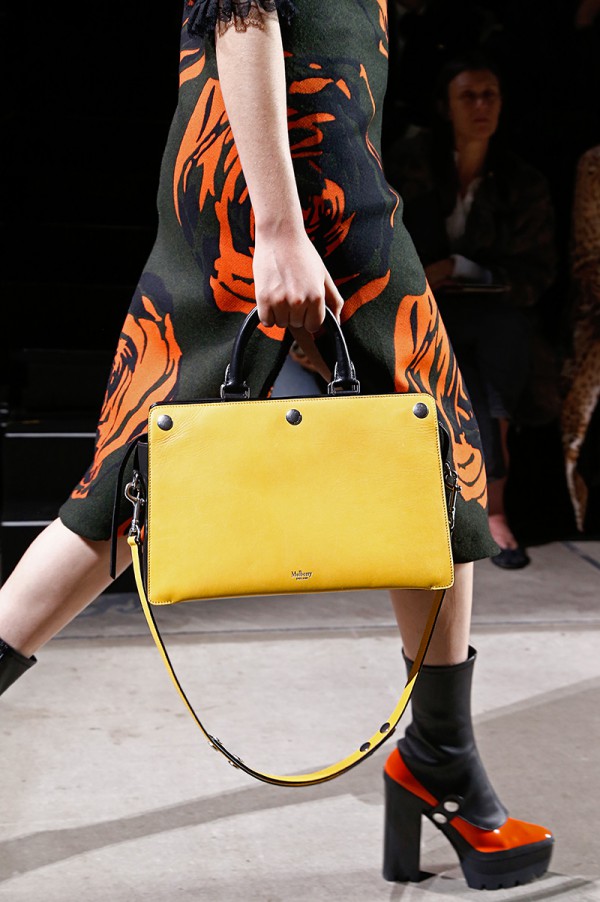Interview: Johnny Coca of Mulberry
Now that Johnny Coca’s heading up the design at Mulberry, we know where to look for the next blockbuster bag.

The designer Johnny Coca (Spanish) wears a personal uniform of a kilt (Scottish), hoop earrings (indeterminate provenance, but very endearing), and is now the creative director for Mulberry (English). After a two-year hiatus without direction and much headway, Mulberry has brought on new blood – proof of post-modernity’s disregard for national boundaries – and Coca’s new vision for the English brand is revitalising, energising and exciting to witness as it unfolds. The FW16 season saw Coca present his debut collection on the London Fashion Week catwalk, complete with ready-to-wear, accessories and, of course, the season’s newest bags.
How did you get into fashion design?
“I think it all began when I had a job in visual design while I was at the École Boulle art school. I had to sketch bags for the windows and I decided to show my designs to Yves Carcelle at Louis Vuitton. I gradually worked my way up. I love to draw and this led to me getting more and more work. I then started to design for more and more product categories: first at Céline with Michael Kors, then at Bally, and then back at Céline again with Phoebe Philo – and now at Mulberry where I am designing the ready-to-wear as well as accessories, shoes, jewellery and travel items.”
How does your education in architecture and physics inspire your work?
“My education in architecture meant choosing the show venue was a very important part of showcasing the collection. The Guildhall – where we showed – was the perfect venue as it really demonstrated the juxtaposition between the old and contemporary, which is very much what the collection was about – contrast.”
As the accessories designer behind some of Céline’s greatest hits, what do you think makes for a successful bag?
“Designing a bag is like building a house – it must be modern, practical, functional and accessible.”
What’s the starting point in your design process?
“It all starts with a concept and then everything stems from there. It’s like a tree – lots of branches with lots of different things create the whole picture.”
Speaking of trees, you’ve scrapped Mulberry’s iconic willow for an archival logotype. What was the reason for your looking back instead of creating something new from scratch?
“It’s important as a creative director to know the heritage and history of the brand. The new logo is an example of this as it’s actually an old Mulberry logo from the 1970s. I found it when I was researching and going through the archives. I felt it could represent the brand in such a modern way while also resurrecting some of Mulberry’s history.”
What were your intentions with your debut at Mulberry?
“To create a modern and accessible collection.”
How did you feel after your first show as a creative director?
“I was full of every emotion possible – happiness, relief, fear… The show was a defining moment for Mulberry and for my career too.”
Were you intimidated by the pressure of becoming the creative face of Mulberry?
“I was extremely humbled and proud to be named the creative director of such an iconic British brand which people love so much. Mulberry is so iconic and has such a prestigious heritage and history, so it was an honour for me to join the team. I’m embracing every part of my role and am excited for what’s to come.”
How do you feel about becoming a ”famous” name now that you are a creative director?
“I am a creative first and foremost, so everything I do, I do for the collections. I want the designs to be able to speak for themselves.”
What are your intentions with Mulberry’s ready-to-wear? Will it, or the bags, drive the brand’s story and identity?
“We’re in the midst of a big modernisation process, which we are very excited about. I’m passionate about design and the whole process that goes with it. It takes so much to go from sketches to catwalk and that’s what excites me. We’re planning to move Mulberry forward by creating more of a lifestyle brand through expanding the product categories into jewellery, sunglasses and shoes, as well as concentrating on the ready-to-wear and, of course, bags. There are lots of things to come. Watch this space!”
Do you think the catwalk presentation format is still relevant for an accessories-driven brand like Mulberry?
“The catwalk shows are extremely important to brands and designers. The FW16 show was a defining moment for Mulberry. We would not have been able to have the impact we wanted – – and had – without a catwalk show.”
Is Mulberry considering a see-now-buy-now approach?
“Yes, Mulberry embraces the new see-now-buy-now approach. Our Pre-Fall capsule collection was available online and in stores worldwide on 1 April. This included key styles, such as the new Clifton and Chester bags, and the Marylebone press studded boots and Mary Janes.”
It’s a funny coincidence that Spain and the UK’s biggest bag brands have swapped creative director nationalities: Jonathan Anderson is at Loewe, and you, a Spaniard, are at Mulberry. Do you think creatives’ nationalities still matter?
“As long as you understand the personality and heritage of the brand, it should not matter where you come from. Mulberry is both a British heritage and an international brand and we want our collections to appeal to women and men around the world.”
Last question: Is there a meaning to your uniform of the kilt, hoop earrings, etc?
“That’s just me. I love kilts and tartan, but I keep it simple with a plain shirt or knit jumper – depending on the British weather!



